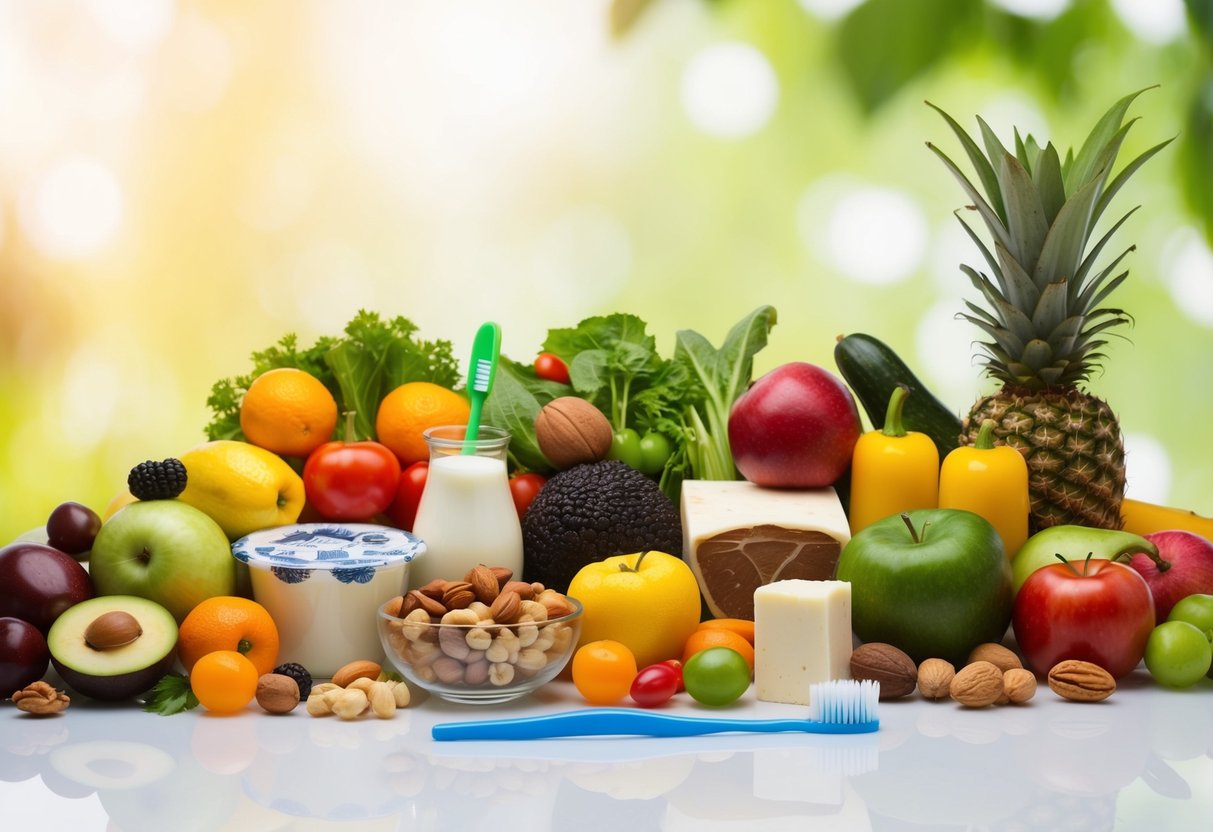Your smile is your superpower, and what you munch on can make or break that pearly white grin of yours! Let’s dish about some tooth-friendly treats that’ll keep your chompers in tip-top shape. From crunchy veggies to creamy dairy delights, there’s a whole world of foods good for teeth waiting to be explored.
Picture this: you’re snacking on a crisp apple, and it’s secretly scrubbing away at plaque like a tiny, tasty toothbrush. Cool, right? And that’s just the beginning! We’re about to dive into a smorgasbord of eats that’ll have your teeth doing a happy dance. So get ready to give your taste buds and your smile a treat they won’t forget!
Building Blocks for Healthy Teeth

The Role of Calcium and Phosphorus
Let’s talk about the dynamic duo your chompers can’t live without: calcium and phosphorus! These minerals are like superheroes for your smile. Dairy products are chock-full of them, so go ahead and indulge in that cheese platter – your teeth will thank you! Not a fan of dairy? No worries! Leafy greens like kale and spinach are excellent alternatives.
Here’s a fun fact: your saliva is like a magical distribution system for these minerals. It spreads them all around your mouth, giving your teeth a protective shield. So, the next time you’re munching on some tooth-friendly foods, give a little nod to your hardworking saliva!
Vitamins for Dental Strength
Vitamins are the unsung heroes of dental health. Vitamin C is your gums’ best friend – it keeps them strong and happy. So, pucker up for some citrus fruits!
Vitamin D is like calcium’s wingman, helping your body absorb this essential mineral. Fancy some fatty fish for dinner? Your teeth certainly do!
And let’s not forget vitamin A. It’s the mastermind behind saliva production. Without it, your mouth would be as dry as the Sahara! Colourful veggies like carrots are packed with this vitamin.
Top Vitamin Sources for Dental Health:
- Vitamin C: Oranges, strawberries, bell peppers
- Vitamin D: Salmon, mackerel, egg yolks
- Vitamin A: Sweet potatoes, spinach, mangoes
Protein-Rich Foods for Tooth Repair
Your teeth are tough cookies, but they need protein to stay that way. Think of protein as the building blocks for tooth repair. Your pearly whites are constantly under siege from bacteria and acids, so they need all the help they can get!
Lean proteins are your go-to here. Chicken, fish, and eggs are all excellent choices. And for all you vegetarians out there, nuts are a fantastic option. They’re not only protein-packed but also loaded with other tooth-loving nutrients.
Try this tooth-strengthening snack: a handful of almonds. They’re high in calcium, low in sugar, and will give you a satisfying crunch without putting your teeth at risk. It’s a win-win situation for your taste buds and your smile!
Preventative Foods and Lifestyle Choices

Natural Defenders Against Bacteria
You’ll be thrilled to know that some foods are like nature’s toothbrushes! Munch on crunchy fruits and veggies like apples, carrots, and celery to scrub away plaque. These fibre-rich snacks are your teeth’s best pals.
Don’t forget about the power of antioxidants! Green tea is packed with polyphenols that fight harmful bacteria. Brew yourself a cuppa and toast to your dental health.
Fancy some shiitake mushrooms? These fabulous fungi are cavity-fighting champions. Toss them in your stir-fry for a tooth-friendly feast.
Hydration and Saliva Production
Your smile’s best mate? Good old H2O! Sipping water throughout the day washes away food bits and keeps your mouth fresh. It’s like a mini shower for your teeth!
Chewing sugar-free gum is a brilliant way to boost saliva production. This natural cleanser helps protect your pearly whites. Look for gum with xylitol for an extra bacteria-busting bonus.
Here’s a quick list of hydration heroes:
- Water (naturally!)
- Green tea
- Sugar-free gum
- Milk (calcium-rich and hydrating)
Mindful Eating Habits
You are what you eat, and so are your teeth! Be mindful of your munching habits. Snacking frequently, especially on sugary or acidic treats, can be tough on your chompers.
Try this tooth-friendly eating plan:
- Enjoy main meals with plenty of crunchy veggies
- Snack on cheese or nuts (calcium and protein powerhouses)
- Rinse with water after eating
- Chew sugar-free gum between meals
Remember, omega-3 fatty acids are fantastic for your overall health, including your gums. Salmon, walnuts, and flaxseeds are delicious sources.
Frequently Asked Questions
What are the top foods that promote dental health?
You’ll be thrilled to know that some delicious foods can actually boost your dental health! Dairy products like cheese, milk, and yogurt are fantastic for your pearly whites. They’re chock-full of calcium and phosphorus, which help fortify your tooth enamel. Don’t forget to munch on leafy greens and nuts too – they’re packed with nutrients that support strong teeth and gums.
Here’s a quick list of tooth-friendly foods:
- Yogurt (calcium-rich and probiotic)
- Carrots (crunchy and full of fibre)
- Celery (natural toothbrush effect)
- Cheese (promotes saliva production)
Which foods should be avoided to maintain healthy teeth?
Now, let’s chat about the foods that might give your teeth a hard time. Sugary foods are the usual suspects – they can lead to tooth decay faster than you can say “cavity”! Sticky foods like dried fruit are also tricky, as they tend to cling to your teeth like little sugar bombs. Acidic foods and drinks can wear down your enamel, so enjoy them in moderation.
How do certain fruits contribute to dental well-being?
Fruits can be your teeth’s best friends! Crunchy fruits like apples and pears are nature’s toothbrushes. They stimulate saliva production, which helps rinse away pesky food particles and bacteria. Berries are bursting with antioxidants that can help keep your gums happy and inflammation-free.


